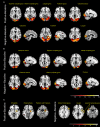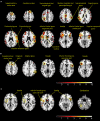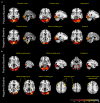Neural Activation During Tonic Pain and Interaction Between Pain and Emotion in Bipolar Disorder: An fMRI Study
- PMID: 30459652
- PMCID: PMC6232121
- DOI: 10.3389/fpsyt.2018.00555
Neural Activation During Tonic Pain and Interaction Between Pain and Emotion in Bipolar Disorder: An fMRI Study
Abstract
Objective: Pain and affective disorders have clear clinical relevance; however, very few studies have investigated the association between pain and bipolar disorder. This study investigated the brain activity of patients with bipolar disorder (BPs) undergoing tonic pain and assessed the interaction between pain and emotion. Methods: Ten BPs and ten healthy controls (HCs) were exposed to emotional pictures (positive, neutral, or negative), tonic pain only (pain session), and emotional pictures along with tonic pain (combined session). A moderate tonic pain was induced by the infusion of hypertonic saline (5% NaCl) into the right masseter muscle with a computer-controlled system. Whole-brain blood oxygenation level dependent (BOLD) signals were acquired using 3T functional resonance imaging (fMRI). Results: Ten BPs and ten healthy participants were included in the final analysis. During the pain session, BPs accepted more saline, but showed lower pain rating scores than HCs. When experiencing pain, BPs showed a significant decrease in the BOLD signal in the bilateral insula, left inferior frontal gyrus (IFG), and left cerebellum as compared with HCs. In the combined session, the activated regions for positive mood (pain with positive mood > baseline) in BPs were the left cerebellum, right temporal gyrus, and left occipital gyrus; the activated regions for negative mood (pain with negative mood > baseline) were the right occipital gyrus, left insula, left IFG, and bilateral precentral gyrus. Conclusions: This study presents the preliminary finding of the interaction between pain and emotion in BPs. BPs exhibited lower sensitivity to pain, and the activation of insula and IFG may reflect the interaction between emotion and pain stimulus.
Keywords: bipolar disorder; functional magnetic resonance imaging (fMRI); inferior frontal gyrus (IFG); insula; pain; visual analog scale (VAS).
Figures




Similar articles
-
Investigation of an emotion perception test using functional magnetic resonance imaging.Comput Methods Programs Biomed. 2019 Oct;179:104994. doi: 10.1016/j.cmpb.2019.104994. Epub 2019 Jul 23. Comput Methods Programs Biomed. 2019. PMID: 31443867
-
Brain Activation During Processing of Depression Emotion in College Students With Premenstrual Syndrome in China: Preliminary Findings.Front Psychiatry. 2022 Jun 27;13:856443. doi: 10.3389/fpsyt.2022.856443. eCollection 2022. Front Psychiatry. 2022. PMID: 35832597 Free PMC article.
-
The interaction of emotion and pain in the insula and secondary somatosensory cortex.Neuroscience. 2017 May 4;349:185-194. doi: 10.1016/j.neuroscience.2017.02.047. Epub 2017 Mar 1. Neuroscience. 2017. PMID: 28259800
-
Facial emotion processing in patients with schizophrenia and their non-psychotic siblings: a functional magnetic resonance imaging study.Schizophr Res. 2012 Feb;134(2-3):143-50. doi: 10.1016/j.schres.2011.10.019. Epub 2011 Nov 22. Schizophr Res. 2012. PMID: 22113155
-
Emotion regulation in mood and anxiety disorders: A meta-analysis of fMRI cognitive reappraisal studies.Prog Neuropsychopharmacol Biol Psychiatry. 2017 Oct 3;79(Pt B):96-104. doi: 10.1016/j.pnpbp.2017.06.001. Epub 2017 Jun 1. Prog Neuropsychopharmacol Biol Psychiatry. 2017. PMID: 28579400 Review.
Cited by
-
The mediating role of emotional regulation and emotional expression in the relationship between autistic traits and empathy in Saudi students.Int J Dev Disabil. 2024 Nov 14;70(6):976-985. doi: 10.1080/20473869.2024.2345956. eCollection 2024. Int J Dev Disabil. 2024. PMID: 39564197
-
Brain stimulation targets for chronic pain: Insights from meta-analysis, functional connectivity and literature review.Neurotherapeutics. 2024 Jan;21(1):e00297. doi: 10.1016/j.neurot.2023.10.007. Epub 2023 Dec 19. Neurotherapeutics. 2024. PMID: 38237403 Free PMC article. Review.
-
Decreased dynamic variability of the cerebellum in the euthymic patients with bipolar disorder.BMC Psychiatry. 2024 Feb 19;24(1):137. doi: 10.1186/s12888-024-05596-4. BMC Psychiatry. 2024. PMID: 38373944 Free PMC article.
References
-
- Giles LL, Nasrallah HA, Singh MK. Too much or too little pain: the dichotomy of pain sensitivity in psychotic versus other psychiatric disorders. Curr Psycho Therapeut Rep. (2006) 4:134–8. 10.1007/BF02629336 - DOI
-
- Minichino A, Delle Chiaie R, Cruccu G, Piroso S, Di Stefano G, Francesconi M, et al. . Pain-processing abnormalities in bipolar I disorder, bipolar II disorder, and schizophrenia: a novel trait marker for psychosis proneness and functional outcome? Bipolar Dis. (2016) 18:591–601. 10.1111/bdi.12439 - DOI - PubMed
LinkOut - more resources
Full Text Sources

